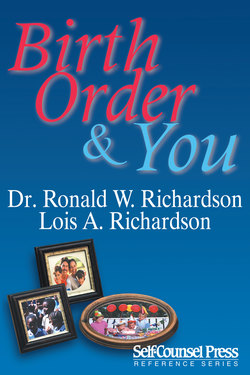Читать книгу Birth Order & You - Dr. Ronald W. Richardson & Lois A. Richardson - Страница 17
b. Your Friends
ОглавлениеFriendships are also affected by birth order. The friends you get along well with are likely to be in a complementary birth position. Non-complementary birth positions may partly explain any tension that exists in a friendship. Differences of opinion that may appear to be the result of rational thinking may simply reflect early family experiences.
Annette and Sue were neighbors, and they enjoyed each other’s company, shared the same interest in local politics, and had children the same age. However, they often had strong disagreements about a variety of issues, especially the subject of men in general and their own spouses in particular. Sue always defended the actions of men, made excuses for her husband’s poor treatment of her, and was critical of feminists. Annette thought Sue’s husband treated her intolerably and couldn’t understand why Sue put up with him. It was no surprise to learn that Sue was the oldest sister of a brother (and therefore used to taking care of men and making excuses for their childish behavior) and Annette was an only child (and most interested in her own and other women’s rights).
If you take note of the kind of relationship you have with various friends and then find out their birth order, you may find that your best friends all have the same birth order. While you may have much in common with people in your same birth order, over the long haul you will probably feel most comfortable with friends from a complementary birth order, especially one that matches that of a favorite sibling.
Manny, an only child, found that he was usually most uncomfortable with friends, male or female, who were oldests. He couldn’t tolerate being with people who wanted to be in charge or who thought they knew best. However, he was also leery of youngests who expected him to be in charge or take care of them. He enjoyed “playing” with the youngests, and liked it when they looked up to him, but would disappear as soon as they indicated he should do something to make life better for them. “Do it yourself” was his attitude. As with many only children, he was his own best friend.
